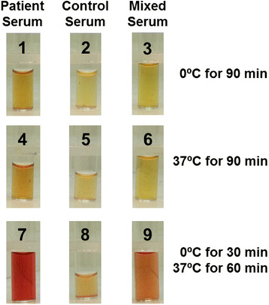Serological endpoints: Hemolysis - Donath-Landsteiner Testing
The most common reason to assess an antibody’s hemolytic capacity is to determine if a patient has paroxysmal cold hemoglobinuria (PCH). In this test, the presence of a biphasic hemolysin (also known as a Donath-Landsteiner antibody) is detected by testing a patient sample in three settings: at 0ºC, at 37ºC, and at 0º followed by 37ºC. If hemolysis occurs only with the third tube, the test is positive.

Donath-Landsteiner testing can be performed either directly (using patient RBCs) or indirectly (using patient serum, which is then incubated with test RBCs). Because patients with PCH are often depleted of complement by the time they are tested, fresh normal serum is usually added to the sample as a source of complement in both direct and indirect DL testing.
